If you’re new to blue light and how it affects sleep, it’s important to know that exposure from screens and LED lighting can delay sleep by reducing melatonin production. Blue light tricks your brain into thinking it’s daytime, disrupting your natural sleep cycle. To protect yourself, limit screen time before bed, use blue light filters or glasses, and adjust device settings. Keep exploring these strategies to improve your sleep and overall well-being.
Key Takeaways
- Blue light from screens and LEDs can suppress melatonin, delaying sleep onset and disrupting circadian rhythms.
- Excessive evening blue light exposure is linked to difficulty falling asleep, poorer sleep quality, and daytime fatigue.
- To protect sleep, limit screen time before bed, use blue light filters or glasses, and opt for warm, dim lighting at night.
- Blue light can cause eye strain, headaches, and discomfort; taking regular breaks and managing exposure helps eye health.
- Choosing devices with built-in blue light management features and establishing consistent routines support better sleep hygiene.
Understanding Blue Light: What Is It?
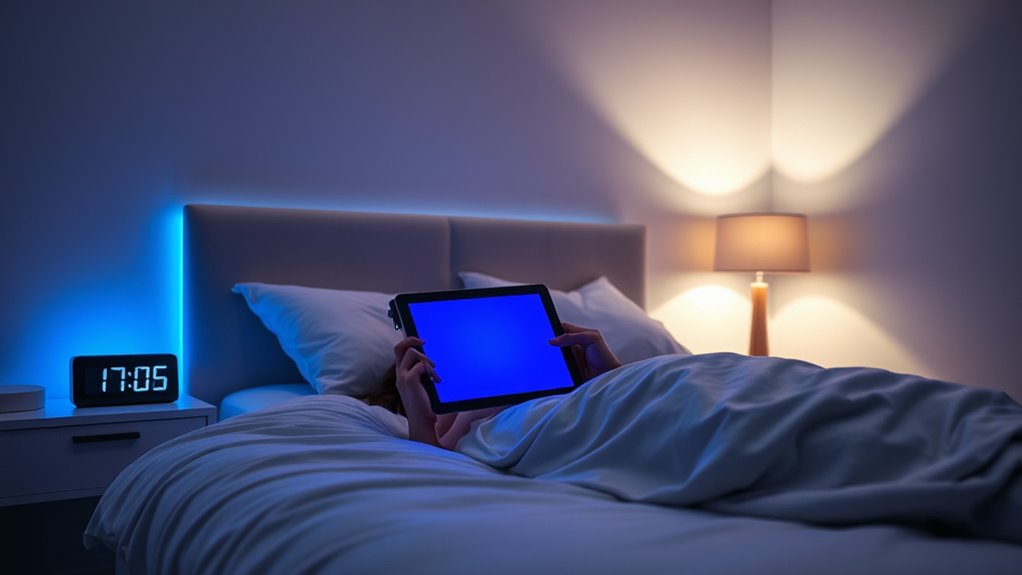
Blue light is a type of high-energy visible light that emits from screens like smartphones, tablets, computers, and LED lighting. This exposure can cause circadian disruption, throwing off your body’s internal clock that regulates sleep and wakefulness. When your circadian rhythm is disturbed, it becomes harder to fall asleep and wake up feeling refreshed. Additionally, blue light contributes to light pollution, which not only affects humans but also disrupts wildlife and ecosystems. Because of its brightness and wavelength, blue light penetrates deep into your eyes, influencing your body’s natural responses to daylight. Understanding blue light helps you recognize its role in modern environments and how excessive exposure can impact your health, especially regarding sleep and overall well-being.
The Connection Between Blue Light and Sleep Patterns

Exposure to blue light, especially during evening hours, directly affects your sleep patterns by interfering with your body’s natural signals for rest. Your circadian rhythms, which regulate sleep-wake cycles, rely on darkness to signal it’s time to sleep. Blue light from screens and light pollution tricks your brain into thinking it’s daytime, delaying melatonin production and making it harder to fall asleep. This disruption can shift your internal clock, leading to inconsistent sleep schedules and poorer sleep quality. Over time, the effects of blue light exposure can cause fatigue and reduce overall restfulness. To protect your circadian rhythms, limit screen time before bed and minimize exposure to artificial light during evening hours. Your sleep quality depends on maintaining a natural cycle free from excessive blue light interference. Studies indicate that the impact of indoor lighting, including blue light, can be minimized by using light filters or glasses, helping to preserve your sleep health.
How Blue Light Affects Your Melatonin Levels
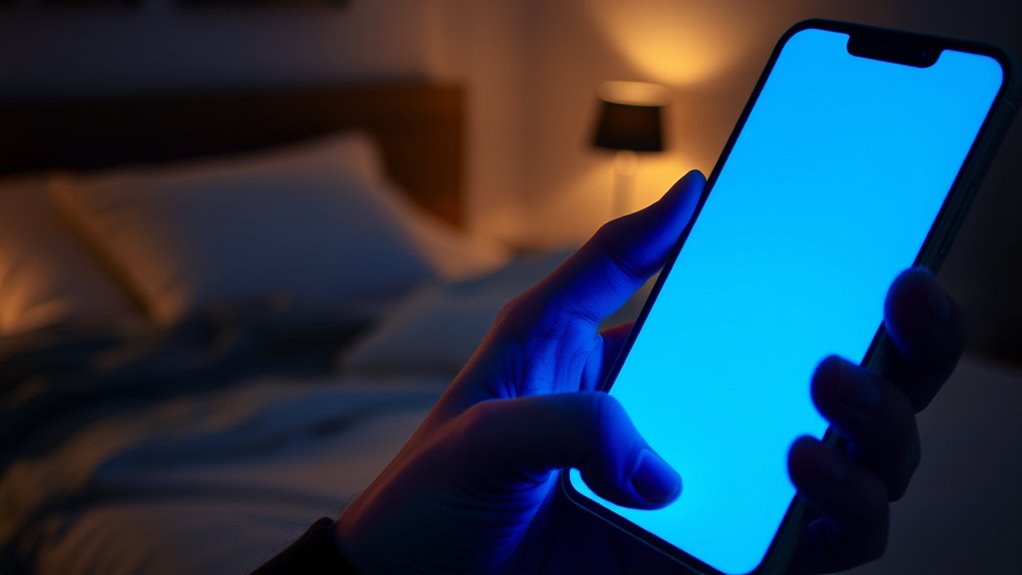
Blue light signals your brain to reduce melatonin production, making it harder for you to feel sleepy. This suppression disrupts your natural sleep cycle and can lead to poorer sleep quality. Understanding this mechanism helps you see why limiting blue light before bed is so important. Being aware of environmental considerations can help you create a more sleep-friendly environment.
Melatonin Suppression Mechanism
When light enters your eyes, specialized cells in your retina detect it and send signals to your brain’s internal clock, the suprachiasmatic nucleus. Blue light, especially from screens, activates these cells, which suppress melatonin production. This suppression disrupts your circadian rhythm, the natural cycle that guides sleep and wakefulness. Instead of feeling sleepy at night, your body stays alert, making it harder to fall asleep. Light therapy can help regulate this process by exposing you to controlled light at specific times, reinforcing your circadian rhythm. By understanding this mechanism, you realize how blue light hampers melatonin levels, affecting your sleep quality. Managing light exposure, especially in the evening, can support your body’s natural melatonin production and promote better sleep.
Impact on Sleep Cycles
The suppression of melatonin caused by light exposure at night directly disrupts your sleep cycles. When blue light diminishes melatonin, your circadian rhythms lose their synchronization, making it harder to fall asleep and wake up refreshed. This disturbance can lead to fragmented sleep and reduced overall rest quality. Light therapy, often used to regulate circadian rhythms in conditions like jet lag or seasonal affective disorder, highlights how light influences sleep patterns. To protect your sleep cycles, limit blue light exposure in the evening and consider using blue light filters on devices. Maintaining consistent sleep and wake times helps reinforce your circadian rhythms, ensuring your body’s internal clock stays aligned with the natural day-night cycle. Incorporating protective styling options like crochet or knitting can also provide a restful environment that minimizes nighttime disturbances.
Common Sources of Blue Light in Daily Life

Many of the screens you use daily emit significant amounts of blue light, which can interfere with your sleep patterns. Smartphones, tablets, computers, and LED TVs are common sources. Even LED lighting indoors contributes to blue light exposure, especially if used late at night. Light therapy devices designed to regulate circadian rhythms also emit blue light, but in controlled amounts. Outdoor sunlight is another major source, providing natural blue light that helps set your internal clock. Prolonged exposure to these sources, particularly before bedtime, can disrupt your sleep cycle. Being aware of these common sources allows you to manage your exposure better, helping your circadian rhythms stay aligned and supporting healthier sleep patterns. Additionally, understanding the impact of blue light exposure can motivate you to adopt strategies like using blue light filters or limiting screen time in the evening.
Signs That Blue Light Might Be Disrupting Your Rest

If you stay up late scrolling on your devices, you might notice trouble falling asleep. You could also experience eye strain and fatigue during the day, which are signs your eyes are reacting to blue light. These symptoms often indicate that blue light is disrupting your rest more than you realize. Additionally, exposure to blue light before bedtime can interfere with your sleep quality, making it harder to achieve restful sleep.
Late Night Screen Use
You might notice you’re having trouble falling asleep after late-night screen time, which could be a sign that blue light is disrupting your rest. Excessive screen use before bed can delay melatonin production, making it harder to drift off. To identify if your habits are affecting sleep, consider these signs:
- Difficulty falling asleep despite feeling tired
- Waking up frequently during the night
- Feeling groggy or unrested in the morning
- Habitual late-night device use ignoring sleep cues
Also, poor device ergonomics can lead to unhealthy posture, increasing discomfort and encouraging prolonged screen time. Being mindful of your screen habits and optimizing ergonomics can help reduce blue light exposure and improve your sleep quality. Cutting back on late-night screen time is a vital step toward better rest.
Research suggests that establishing a relaxation routine before bed can further support your sleep hygiene and help counteract the effects of blue light.
Eye Strain and Fatigue
Extended screen time late at night not only affects your sleep but can also lead to eye strain and fatigue. If you notice your eyes feeling tired, dry, or gritty after screen use, blue light may be a culprit. These symptoms hinder your visual comfort and can cause eye fatigue, making it harder to focus or see clearly. Watch for signs like headaches, blurred vision, or sensitivity to light. To help, consider adjusting screen brightness, taking regular breaks, and reducing blue light exposure. Here’s a quick guide:
| Symptom | Cause | Solution |
|---|---|---|
| Eye discomfort | Blue light exposure | Use blue light filters |
| Headaches | Eye strain from fatigue | Take frequent breaks |
| Blurred vision | Overuse without rest | Practice the 20-20-20 rule |
| Dry eyes | Reduced blinking | Use artificial tears |
Prioritize your eye health for better sleep and overall well-being. Additionally, incorporating on-device AI features like adaptive brightness can help minimize strain.
Difficulty Falling Asleep
Blue light exposure before bedtime can interfere with your body’s natural sleep signals, making it harder to fall asleep quickly. If you notice you’re lying awake longer than usual, your sleep hygiene or bedtime routines might be disrupted by blue light. Here are four signs that blue light could be affecting your ability to drift off:
- You stay awake despite feeling tired.
- Your sleep onset takes longer than 20 minutes.
- You wake up frequently during the night.
- You feel groggy or unrested in the morning.
Adjusting your bedtime routines—like avoiding screens an hour before bed—can improve your sleep quality. Protecting your sleep hygiene helps reset your body’s natural rhythms and promotes faster, more restful sleep.
Simple Ways to Reduce Blue Light Exposure Before Bed
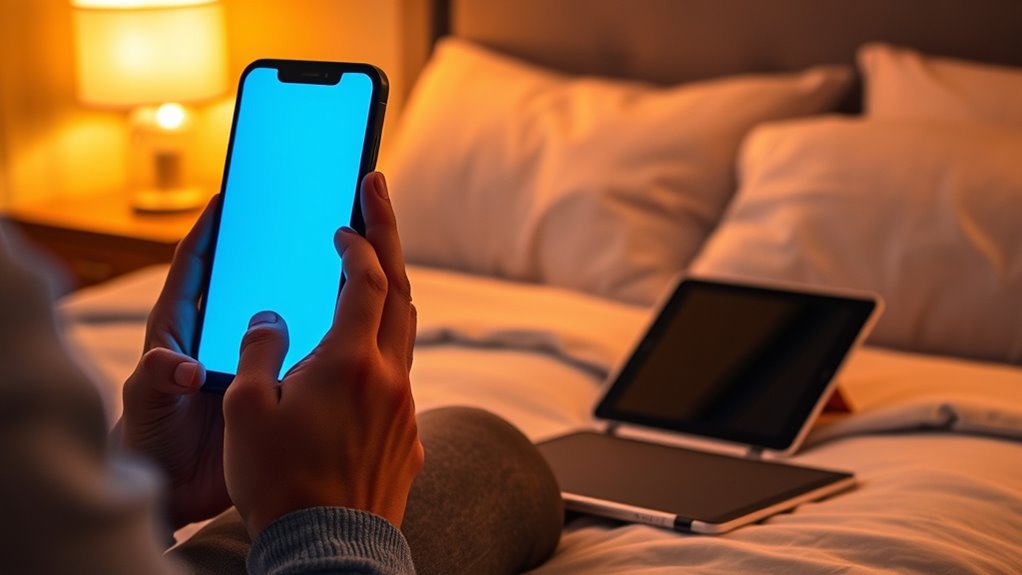
Reducing blue light exposure before bed can considerably improve your sleep quality. One simple way is to minimize screen time an hour before bedtime, allowing your circadian rhythms to naturally prepare for sleep. Using dim, warm-colored lighting in your home can also help signal to your body that it’s time to wind down. Light therapy devices designed for evening use can support your circadian rhythms without disrupting your sleep-wake cycle. Additionally, avoiding bright screens resets your internal clock, making it easier to fall asleep and stay asleep. By consciously limiting blue light exposure through these small changes, you help your body produce melatonin naturally, leading to better rest and overall sleep health. Necessary cookies also ensure essential site functionalities, making your browsing experience smoother while you implement these sleep-friendly habits.
Choosing Devices and Settings to Minimize Blue Light Impact

When selecting devices to reduce blue light, look for ones with built-in night modes or blue light filters. Adjust your screen brightness to a comfortable level to prevent eye strain and lessen blue light exposure. Making these small changes can substantially improve your sleep quality. Additionally, incorporating AI-driven solutions in health technology may further optimize your sleep environment and habits.
Selecting Appropriate Devices
Choosing the right devices and adjusting their settings can considerably reduce your exposure to blue light, especially during evening hours. Focus on selecting devices with good compatibility for blue light filters and proven brand reliability. Consider these key points: 1. Device Compatibility: Make sure your device supports built-in or downloadable blue light reduction features. 2. Brand Selection: Opt for reputable brands known for quality and effective blue light filters. 3. Screen Type: Prioritize devices with matte screens or those that offer customizable display settings. 4. Update Capabilities: Choose devices that regularly receive software updates for improved blue light management. Additionally, understanding the importance of color accuracy can help you select displays that minimize eye strain while maintaining visual clarity.
Adjusting Screen Brightness
Adjusting screen brightness plays a pivotal role in minimizing blue light exposure, especially during evening hours when your body prepares for sleep. Lowering your screen brightness reduces the intensity of blue light emitted, making it less disruptive to your circadian rhythm. Additionally, adjusting display contrast can help lessen eye strain and improve comfort, allowing you to see clearly without increasing brightness excessively. Many devices offer automatic brightness settings, which adapt to surrounding light, or manual adjustments you can customize. Keep your screen dimmer in the evening and avoid high contrast settings that make blue light more noticeable. By fine-tuning your screen brightness and display contrast, you create a more sleep-friendly environment, helping your body wind down naturally. Unplanned weather changes can sometimes create comical outcomes that make your viewing experience more comfortable and less disruptive.
The Role of Screen Time Management in Better Sleep

Managing your screen time is essential for better sleep because excessive exposure to screens, especially before bedtime, can interfere with your body’s natural sleep cycle. To improve your sleep hygiene, consider these strategies:
Limiting screen time before bed boosts sleep quality by supporting your body’s natural cycle.
- Limit screen use at least an hour before bed to reduce blue light exposure.
- Set specific time limits for evening screen activities.
- Use alarms or reminders to pause screen time.
- Prioritize relaxing, non-screen activities to wind down.
- Incorporate screen time management techniques to create healthier habits and support your sleep quality.
Benefits of Incorporating Blue Light Filters and Glasses
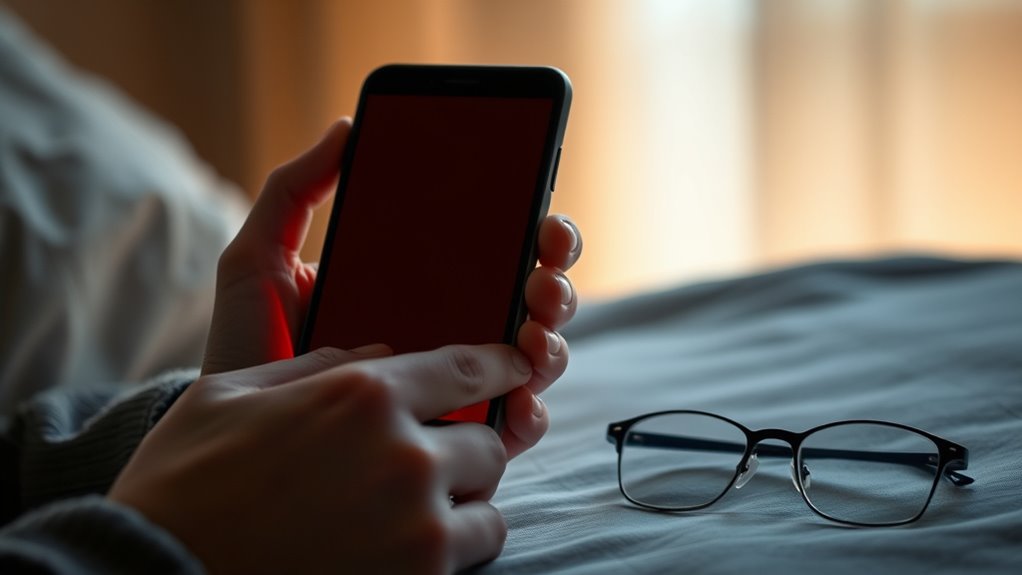
Incorporating blue light filters and glasses can considerably enhance your sleep quality by reducing exposure to the blue light emitted from screens. This directly supports blue light safety, helping protect your eyes from strain and potential damage. Advanced filter technology minimizes blue light transmission, making it easier to wind down at night without sacrificing screen use. Wearing glasses with blue light filters can also prevent circadian rhythm disruption, promoting more natural melatonin production. These tools are simple yet effective strategies to mitigate the negative effects of prolonged screen time. By integrating blue light filters into your daily routine, you can enjoy improved sleep, decreased eye discomfort, and better overall eye health. They’re a practical step toward safeguarding your sleep hygiene in a digital world.
When to Seek Professional Advice About Sleep and Light Exposure
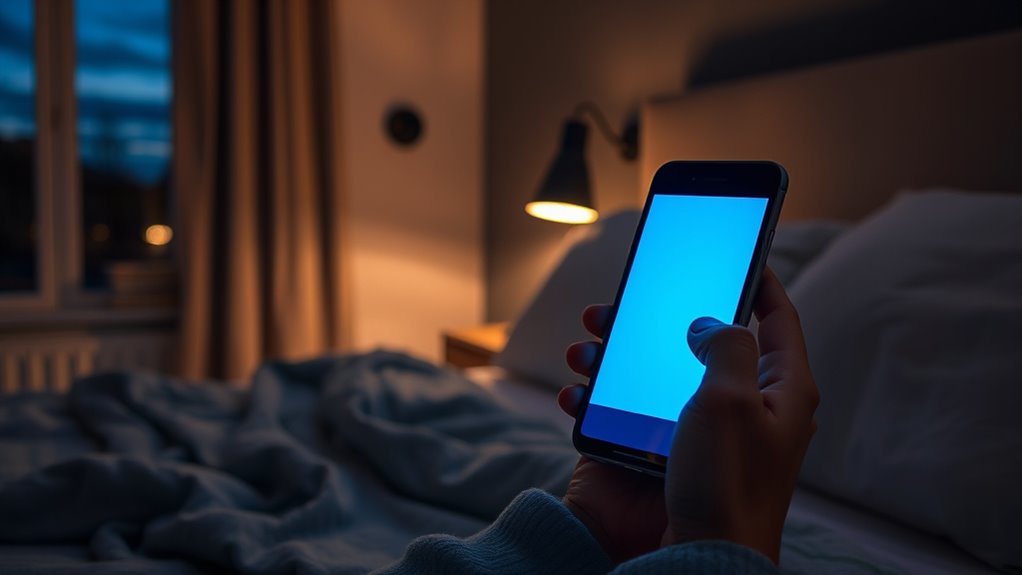
If you notice persistent difficulty falling asleep, staying asleep, or feeling unusually tired during the day despite minimizing blue light exposure, it may be time to consult a healthcare professional. Your circadian rhythms might need adjustment, or underlying issues could be affecting your sleep. Consider seeking advice if:
- Sleep problems persist after using blue light filters or glasses.
- You experience daytime fatigue or mood changes.
- Light therapy is being considered to reset your circadian clock.
- Sleep issues interfere with daily activities or health.
A professional can evaluate your sleep patterns and recommend treatments like light therapy or other interventions to restore healthy circadian rhythms. Don’t ignore ongoing sleep difficulties—they could signal a deeper problem requiring expert help.
Frequently Asked Questions
Can Blue Light Exposure Improve Alertness During the Day?
Yes, blue light exposure can improve alertness during the day by helping regulate your circadian rhythm. When you get blue light during daytime hours, it signals your brain to stay awake and alert, giving you an alertness boost. Just make sure you’re exposed to it at appropriate times, as too much blue light in the evening can disrupt your sleep cycle. Proper exposure helps you stay focused and energized throughout the day.
Are There Specific Times When Blue Light Is More Harmful?
Blue light’s danger looms like a midnight fog, especially during evening hours. You should be cautious because of timing sensitivity—exposing yourself to blue light late at night can trick your brain into thinking it’s daytime, disrupting sleep. So, avoid screens an hour or two before bed, and limit evening exposure. Prioritizing this can help protect your sleep quality and overall well-being.
Do All Blue Light Filters Work Equally Well?
Not all blue light filters work equally well, as filter effectiveness varies based on the technology used and user preferences. Some filters block more blue light, offering better protection, while others may be less effective but more transparent or comfortable. You should try different options to find the one that best suits your needs, balancing blue light reduction with screen clarity and comfort. Personal preferences play a big role in choosing the right filter.
How Long Does Blue Light Exposure Take to Affect Sleep?
You might notice sleep disruption after just one hour of blue light exposure, but it varies with duration. Longer blue light duration before bedtime can delay melatonin production, making it harder to fall asleep. Even brief exposure can interfere, especially if you’re sensitive. To minimize sleep disruption, try reducing screen time or using blue light filters in the evening. Your sleep quality benefits from limiting blue light exposure well before bed.
Is Blue Light Exposure Linked to Long-Term Eye Health Issues?
Yes, blue light exposure can be linked to long-term eye health issues like retinal damage and age-related macular degeneration. When you expose your eyes repeatedly or for extended periods, it may cause oxidative stress on your retina, increasing the risk of damage over time. To protect your eyes, consider wearing blue light glasses, reducing screen time, and taking regular breaks from digital devices.
Conclusion
If you ignore blue light, you risk turning your nights into endless battles with insomnia, leaving you a zombie in the daylight. By understanding its power over your sleep and making simple changes, you hold the key to reclaiming restful nights and vibrant mornings. Don’t let blue light enslave your sleep cycle—take control now, or prepare for a future where exhaustion rules your every moment. Your best sleep is just a few mindful steps away.









